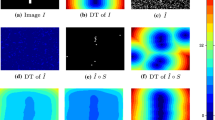Abstract
A new operator named “probability metric” (PM) for defining the distance between random values or random vectors is proposed. Although the PM is a generalisation of the metric operator it does not satisfy the first metric axiom. Two particular forms of PM, for normal and uniform probability distributions are presented. Numerical example demonstrates the efficiency of PM in Shepard-Liszka approximation of residual stresses state discrete data, obtained from a strain gauge experiment. Possible applications of PM include fringe pattern analysis. The PM can be also employed in quantum mechanics issues to estimate the distance of two quantum particles expressed by their wave functions.
Similar content being viewed by others
Author information
Authors and Affiliations
Corresponding author
Rights and permissions
About this article
Cite this article
Łukaszyk, S. A new concept of probability metric and its applications in approximation of scattered data sets. Computational Mechanics 33, 299–304 (2004). https://doi.org/10.1007/s00466-003-0532-2
Received:
Accepted:
Published:
Issue Date:
DOI: https://doi.org/10.1007/s00466-003-0532-2



